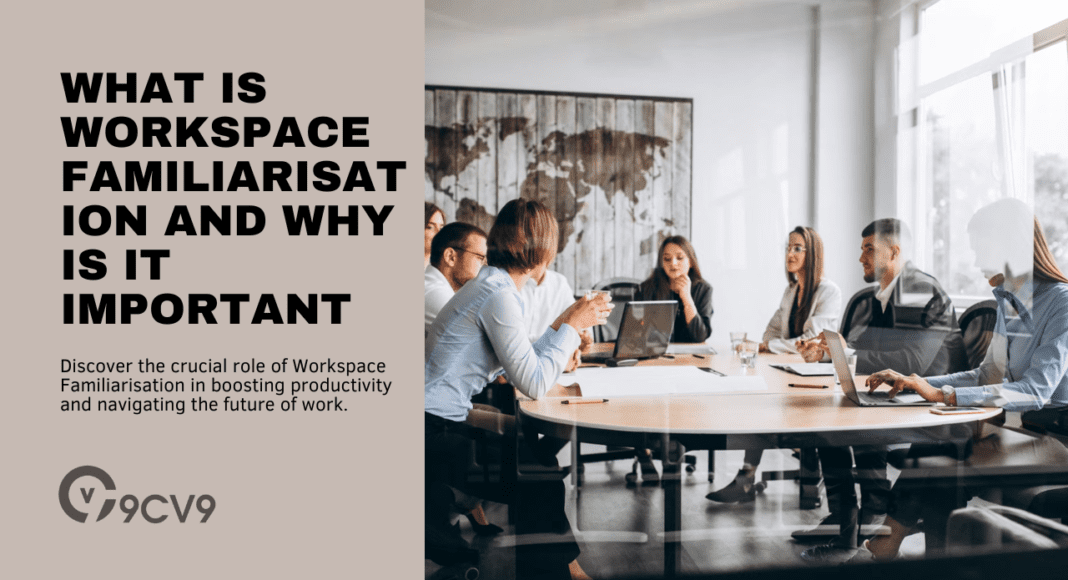Key Takeaways
- Boost Productivity Through Familiarity: Mastering both physical and digital workspaces reduces learning curves, streamlining workflows, and accelerating task execution.
- Navigate Hybrid Work Seamlessly: Embrace the importance of workspace familiarisation in a hybrid work model, ensuring a smooth transition between in-person and virtual collaboration.
- Future-Proof Your Workspace with Technology: Anticipate the integration of advanced technologies like augmented reality (AR) and virtual reality (VR) for an immersive and adaptable workspace.
In the rapidly evolving landscape of modern work environments, the concept of Workspace Familiarisation has emerged as a pivotal element in shaping the success of individuals and organizations alike.
As we witness a paradigm shift towards remote and hybrid work models, the need for employees to navigate seamlessly through their digital and physical workspaces becomes more pronounced than ever before.

Defining Workspace Familiarisation: Workspace Familiarisation is the process of acquainting individuals with their designated work environment, encompassing both the tangible aspects of the physical workspace and the intricate web of digital tools and technologies essential for day-to-day operations.
It is the art of ensuring that employees are not only proficient in using the tools at their disposal but are also attuned to the ergonomic nuances of their physical surroundings.
From the layout of their workspace to the mastery of software applications, Workspace Familiarisation aims to empower individuals to navigate their professional terrain with confidence and efficiency.
The Significance of Workspace Familiarisation: At the heart of this concept lies the recognition of its profound impact on productivity, efficiency, and overall job satisfaction.
The seamless integration of individuals into their workspaces translates to a significant reduction in the learning curve associated with new roles or technologies.
It cultivates a sense of confidence and empowerment, leading to heightened job satisfaction and improved employee morale.
In the realm of productivity enhancement, Workspace Familiarisation acts as a catalyst.
By optimizing the physical workspace for comfort and efficiency, and ensuring mastery of digital tools, organizations can witness a substantial increase in their workforce’s efficiency.
As employees become adept at utilizing the resources at their disposal, the ripple effect is felt in streamlined workflows, faster task execution, and ultimately, the achievement of organizational goals.
Adaptability in Changing Work Structures: With the global shift towards remote and hybrid work models, the importance of Workspace Familiarisation takes on a new dimension.
Employees now grapple with the challenges of navigating virtual spaces, collaborating across distances, and seamlessly transitioning between various digital platforms.
An adept understanding of digital tools and effective workspace setup becomes imperative for success in this evolving landscape.
Strategies for Effective Workspace Familiarisation: Ensuring workspace familiarity is not a one-time endeavor but an ongoing process embedded in organizational culture.
Robust onboarding processes that integrate workspace familiarisation, mentorship programs, and continuous training initiatives are essential elements.
This proactive approach ensures that employees stay abreast of technological advancements and can adapt swiftly to the evolving demands of their roles.
Embarking on a Journey of Exploration: In the subsequent sections of this comprehensive blog, we will delve deeper into the tangible elements of physical workspaces, exploring the impact of ergonomics and layout on employee well-being.
Simultaneously, we will navigate the intricate realm of digital tools and software, shedding light on the crucial role they play in enhancing productivity and collaboration.
Buckle up as we embark on a journey to unravel the layers of Workspace Familiarisation, understanding not just what it is but why it stands as a linchpin in the contemporary narrative of work.
Through real-world case studies, practical strategies, and a glimpse into the future trends, we aim to equip you with insights that transcend the theoretical, empowering you to harness the full potential of your workspace for unparalleled professional success.
Before we venture further into this article, we like to share who we are and what we do.
About 9cv9
9cv9 is a business tech startup based in Singapore and Asia with a strong presence all over the world.
With over eight years of startup and business experience, and being highly involved in connecting with thousands of companies and startups, the 9cv9 team has listed some important learning points in this overview of What is Workspace Familiarisation and Why is it Important.
If your company needs recruitment and headhunting services to hire top employees, you can use 9cv9 headhunting and recruitment services to hire top talents and candidates. Find out more here, or send over an email to [email protected].
Or just post 1 free job posting here at 9cv9 Hiring Portal in under 10 minutes.
What is Workspace Familiarisation and Why is it Important
- The Significance of Workspace Familiarisation
- Elements of Workspace Familiarisation
- Benefits for Remote and Hybrid Work Environments
- Strategies for Effective Workspace Familiarisation
- Future Trends in Workspace Familiarisation
1. The Significance of Workspace Familiarisation
Enhanced Productivity Through Proficiency:
- Reduced Learning Curve:
- Workspace Familiarisation significantly reduces the learning curve associated with new roles or technologies.
- Employees who are well-versed in their workspace demonstrate quicker adaptation to new tools and processes.
- Streamlined Workflows:
- Proficient individuals contribute to streamlined workflows, as they efficiently navigate through tasks and processes.
- This proficiency minimizes the likelihood of errors and bottlenecks, fostering a more productive work environment.
- Faster Task Execution:
- Familiarity with digital tools and physical workspace translates to quicker task execution.
- Swift navigation through software applications and seamless use of equipment results in time-saving benefits.

Employee Engagement and Job Satisfaction:
- Confidence and Empowerment:
- Employees who feel confident in their ability to use tools and navigate their workspace experience a sense of empowerment.
- This empowerment positively impacts job satisfaction and overall engagement.
- Positive Work Environment:
- A familiar and comfortable workspace contributes to a positive work environment.
- This positivity has a cascading effect on employee morale and collaboration, fostering a culture of teamwork and creativity.
- Alignment with Job Preferences:
- Workspace Familiarisation ensures that the physical and digital aspects of the workspace align with individual job preferences.
- When employees feel their workspace supports their work style, it enhances job satisfaction.
Real-world Examples of Workspace Familiarisation Success:
- Google’s Innovative Workspace Design:
- Google is renowned for its innovative workspace designs that prioritize employee comfort and collaboration.
- Open spaces, ergonomic furniture, and creatively designed breakout areas contribute to a workspace that fosters creativity and innovation.
- Atlassian’s Digital Collaboration:
- Atlassian, a leading software company, emphasizes digital workspace familiarisation.
- With tools like Jira and Confluence, employees collaboratively manage projects, enhancing productivity and ensuring everyone is on the same page.
- Microsoft’s Focus on Hybrid Work:
- Microsoft has embraced a hybrid work model, emphasizing the importance of digital workspace familiarisation.
- Through Microsoft Teams and integrated tools, employees seamlessly transition between in-person and virtual collaboration, ensuring productivity remains high.
Impact on Remote and Hybrid Work Environments:
- Adaptability to Virtual Spaces:
- In remote work scenarios, digital workspace familiarisation becomes crucial.
- Employees must navigate virtual spaces efficiently, making familiarity with communication and collaboration tools imperative.
- Tools for Seamless Collaboration:
- Collaboration tools such as Slack, Zoom, and Microsoft Teams play a pivotal role in hybrid work environments.
- Familiarity with these tools ensures effective communication and collaboration irrespective of physical location.
- Overcoming Challenges in Hybrid Models:
- Hybrid work models bring unique challenges, including the need for effective workspace transitions.
- Workspace Familiarisation strategies address these challenges, ensuring a smooth blend of in-person and virtual collaboration.
In conclusion, the significance of Workspace Familiarisation is multi-faceted, encompassing enhanced productivity, improved employee engagement, and adaptability to evolving work structures.
Real-world examples highlight the success of companies that prioritize workspace familiarity, serving as inspiration for others to invest in creating environments that empower their workforce.
As we delve into the strategies for effective workspace familiarisation in the subsequent sections, the overarching theme remains clear: a familiar workspace is a catalyst for individual and organizational success.
2. Elements of Workspace Familiarisation
Physical Workspace Optimization:
- Ergonomics and Comfort:
- Ergonomic furniture and equipment contribute to a comfortable physical workspace.
- Examples include adjustable chairs, standing desks, and ergonomic keyboards that enhance employee well-being.
- Layout and Accessibility:
- Thoughtful workspace layouts promote accessibility and efficient movement.
- Open floor plans, designated collaborative areas, and strategically placed tools contribute to an accessible and well-organized workspace.
- Lighting and Ambiance:
- Adequate lighting and a positive ambiance impact employee mood and focus.
- Natural light, well-designed lighting fixtures, and personalized workspaces contribute to an inviting atmosphere.

Digital Tools and Software Integration:
- Overview of Essential Tools:
- Identification and provision of tools necessary for daily tasks.
- Examples include project management software (e.g., Trello, Asana), communication tools (e.g., Slack, Microsoft Teams), and industry-specific applications.
- Training and Integration:
- Comprehensive training programs for digital tools.
- Integration of tools into daily workflows, ensuring seamless utilization.
- User-Friendly Interfaces:
- Selection of tools with intuitive user interfaces.
- Examples include software with easy navigation and minimal learning curves, facilitating quick adoption.
Incorporating Personalization:
- Personal Workspace Customization:
- Allowing employees to personalize their workspace within organizational guidelines.
- Personal touches, such as photos or decorations, contribute to a sense of ownership.
- Digital Preferences and Customization:
- Customizable settings in digital tools.
- Examples include customizable dashboards in project management tools or personalized settings in communication platforms.
- Adaptation to Individual Work Styles:
- Recognition and accommodation of diverse work styles.
- Flexible workspace designs that cater to various working preferences, such as collaborative spaces for team projects and quiet areas for focused work.
Technology Infrastructure:
- Reliable Hardware:
- Provision of reliable and up-to-date hardware.
- Examples include computers, monitors, and other devices that meet the technological demands of the tasks at hand.
- Secure Network Connectivity:
- Ensuring a secure and robust network infrastructure.
- Virtual Private Networks (VPNs), secure Wi-Fi, and data encryption contribute to a safe and stable digital workspace.
- Tech Support and Troubleshooting:
- Access to efficient tech support and troubleshooting resources.
- A responsive IT team and clear channels for issue resolution ensure uninterrupted workflow.
Collaborative Spaces and Communication Channels:
- Designated Collaborative Areas:
- Physical spaces designed for team collaboration.
- Examples include meeting rooms equipped with collaborative tools and digital whiteboards.
- Effective Communication Platforms:
- Adoption of communication platforms that facilitate real-time interaction.
- Video conferencing tools, instant messaging platforms, and project-specific communication channels contribute to seamless collaboration.
- Encouraging Open Communication:
- Creating a culture that encourages open communication.
- Platforms that foster transparency and open dialogue, promoting a collaborative and communicative work environment.
In essence, the elements of Workspace Familiarisation span the physical and digital realms, encompassing ergonomic considerations, comprehensive digital tool integration, personalization options, robust technology infrastructure, and collaborative spaces.
As we explore strategies for effective workspace familiarisation in the subsequent sections, the focus remains on cultivating environments that empower individuals to thrive in both their physical and digital workspaces.
3. Benefits for Remote and Hybrid Work Environments
Adaptability to Remote Work Structures:
- Flexible Workspace Dynamics:
- Remote work demands adaptability to diverse work structures.
- Employees equipped with workspace familiarisation navigate the challenges of remote work seamlessly.
- Remote Collaboration Tools:
- Familiarity with collaboration tools designed for remote work.
- Examples include video conferencing platforms like Zoom and virtual project management tools like Basecamp.
- Remote Productivity Platforms:
- Integration with platforms that enhance remote productivity.
- Cloud-based document collaboration tools, like Google Workspace and Microsoft 365, facilitate efficient remote teamwork.

Tools for Seamless Hybrid Collaboration:
- Integration of Virtual and Physical Workspaces:
- Hybrid work models necessitate the integration of virtual and physical workspaces.
- Employees with workspace familiarisation smoothly transition between in-person and virtual collaboration.
- Hybrid Meeting Solutions:
- Adoption of hybrid meeting solutions for synchronous collaboration.
- Tools like Cisco Webex and Microsoft Teams offer features that bridge the gap between in-office and remote participants.
- Unified Communication Platforms:
- Utilization of unified communication platforms that ensure consistent communication across diverse work structures.
- Integrated platforms like Slack, which seamlessly connect remote and in-office teams, exemplify the benefits of workspace familiarisation in hybrid models.
Also, read our top guide on 5 Essential Remote Work Tips for Boosting Your Productivity.
Overcoming Challenges in Hybrid Models:
- Seamless Workspace Transitions:
- Hybrid work models pose challenges in transitioning between physical and virtual workspaces.
- Employees with workspace familiarisation navigate these transitions effortlessly, ensuring a smooth workflow.
- Digital Onboarding for Hybrid Teams:
- Incorporation of digital onboarding processes for hybrid teams.
- Virtual orientation sessions and training modules on digital tools enable new hires to acclimate swiftly to the hybrid work environment.
- Maintaining Team Connectivity:
- Focus on maintaining team connectivity despite physical distance.
- Regular virtual team-building activities and communication channels foster a sense of unity among remote and in-office team members.
Enhanced Flexibility and Work-Life Balance:
- Remote Work Flexibility:
- Workspace familiarisation empowers employees to work remotely without sacrificing productivity.
- This flexibility contributes to improved work-life balance and enhances job satisfaction.
- Reduced Commuting Stress:
- Remote and hybrid work models alleviate commuting stress.
- Employees experience less strain associated with daily commutes, leading to improved well-being and increased energy for work-related tasks.
- Personalized Work Environments:
- Individuals can create personalized work environments at home.
- This customization contributes to a comfortable and conducive workspace that enhances focus and overall job performance.
Cost Savings and Environmental Impact:
- Reduced Overhead Costs:
- Hybrid and remote work models reduce overhead costs for organizations.
- Savings on office space, utilities, and other infrastructure expenses result in cost-effective operations.
- Eco-Friendly Practices:
- Remote and hybrid work align with eco-friendly practices.
- Reduced commuting translates to a smaller carbon footprint, contributing to sustainability goals.
- Digital Documentation and Reduced Paper Usage:
- Workspace familiarisation encourages the use of digital documentation.
- Reduced reliance on paper not only enhances efficiency but also aligns with environmentally conscious practices.
In summary, the benefits of workspace familiarisation in remote and hybrid work environments are vast, ranging from adaptability to diverse work structures to fostering enhanced flexibility and work-life balance.
Real-world examples of successful hybrid collaboration and the strategic integration of remote work tools underscore the pivotal role of workspace familiarisation in shaping the future of work.
As organizations continue to embrace flexible work models, the value of equipping employees with a familiar and versatile workspace becomes increasingly evident.
4. Strategies for Effective Workspace Familiarisation
Comprehensive Onboarding Processes:
- Incorporating Workspace Familiarisation in Onboarding:
- Infuse workspace familiarisation elements into the onboarding process.
- Orientation sessions that cover both physical and digital workspaces, ensuring new hires are acquainted with tools and the layout of their physical workspace.
- Mentoring and Support Programs:
- Establish mentorship programs to provide ongoing support.
- Seasoned employees can guide newcomers through practical aspects of workspace familiarisation, offering insights and tips for a smoother integration.
- Digital Onboarding Modules:
- Develop digital onboarding modules for remote employees.
- Interactive online modules covering digital tools, virtual collaboration platforms, and best practices for remote work contribute to effective workspace familiarisation.
Continuous Training and Updates:
- Importance of Ongoing Learning:
- Emphasize the significance of continuous learning in a dynamic work environment.
- Regular training sessions and workshops that keep employees abreast of new tools and technologies in their workspace.
- Adapting to Technological Advances:
- Foster a culture of adaptability to technological advancements.
- Organizations should encourage employees to embrace new features and updates in digital tools, ensuring they remain proficient in an ever-evolving digital landscape.
- Cross-Training Initiatives:
- Implement cross-training initiatives to broaden skill sets.
- Cross-training programs expose employees to various aspects of the organization’s operations, enhancing their overall familiarity with diverse workspaces.
Feedback Loops and Improvement Mechanisms:
- Regular Employee Feedback Sessions:
- Conduct regular feedback sessions to gauge employee experiences.
- Direct feedback from employees provides valuable insights into the effectiveness of workspace familiarisation strategies, allowing for continuous improvement.
- Surveys and Data Analysis:
- Utilize surveys and data analysis to identify pain points.
- Quantitative and qualitative data can pinpoint areas where employees may be facing challenges, guiding adjustments in workspace familiarisation approaches.
- Implementing Employee Suggestions:
- Actively implement suggestions from employees.
- Employees often offer valuable insights based on their day-to-day experiences, and their suggestions should be considered in refining workspace familiarisation strategies.
Encouraging Peer-to-Peer Knowledge Sharing:
- Establishing Knowledge Sharing Platforms:
- Create platforms for peer-to-peer knowledge sharing.
- Internal forums, collaborative spaces, or digital channels where employees can share tips and tricks related to workspace familiarisation.
- Recognition and Rewards for Knowledge Sharing:
- Implement recognition and reward programs for knowledge sharing.
- Employees who actively contribute to the knowledge-sharing culture should be acknowledged, fostering a collaborative environment.
- Cross-Departmental Collaborations:
- Facilitate cross-departmental collaborations.
- Encourage employees from different departments to share insights, promoting a holistic understanding of workspace dynamics within the organization.
User-Friendly Documentation and Resources:
- Centralized Knowledge Base:
- Establish a centralized knowledge base for workspace-related information.
- A well-organized repository of documents, video tutorials, and FAQs can serve as a go-to resource for employees seeking information on workspace familiarisation.
- User-Friendly Guides and Manuals:
- Develop user-friendly guides and manuals for digital tools.
- Clear and concise documentation ensures that employees can quickly reference information, promoting self-sufficiency in navigating their digital workspace.
- Interactive Learning Resources:
- Implement interactive learning resources.
- Gamified training modules or interactive guides can engage employees in a more dynamic learning experience, enhancing retention of workspace familiarisation concepts.
Effective workspace familiarisation strategies are rooted in comprehensive onboarding processes, continuous training, feedback loops, peer-to-peer knowledge sharing, and user-friendly documentation.
As organizations embrace these strategies, they empower employees to navigate their physical and digital workspaces with confidence, fostering a culture of adaptability and continuous improvement.
5. Future Trends in Workspace Familiarisation
Integration of Advanced Technologies:
- Emergence of Augmented Reality (AR):
- Anticipate the integration of AR for immersive workspace familiarisation.
- Examples include AR applications guiding employees through physical office layouts or providing real-time assistance with digital tools.
- Virtual Reality (VR) for Remote Collaboration:
- VR technology may be leveraged for remote collaboration.
- Virtual meeting spaces and collaborative environments in VR can enhance the virtual workspace familiarisation experience.
- AI-driven Personalization:
- Artificial Intelligence (AI) will play a role in personalizing workspaces.
- AI algorithms can analyze individual work patterns and preferences, offering tailored recommendations for optimal workspace setups.
Evolving Work Culture and Hybrid Models:
- Permanent Shift to Hybrid Work:
- The hybrid work model is expected to become a permanent fixture.
- Organizations will prioritize strategies that blend in-person and virtual collaboration, necessitating advanced workspace familiarisation approaches.
- Flexibility in Workspace Design:
- Workspace designs will become more flexible to accommodate diverse work styles.
- Modular and adaptable physical workspaces will be designed to cater to changing needs and preferences.
- Cultural Integration of Remote Work:
- Remote work will be culturally integrated into organizational structures.
- Workspace familiarisation will extend beyond digital tools to include cultural assimilation strategies for remote and hybrid teams.
Security and Privacy in Virtual Spaces:
- Enhanced Cybersecurity Measures:
- Anticipate increased emphasis on cybersecurity in virtual workspaces.
- Organizations will implement robust security measures to protect sensitive data in the context of remote and hybrid work.
- Privacy Controls in Collaboration Tools:
- Collaboration tools will feature enhanced privacy controls.
- Employees will have more control over their digital workspaces, including who can access their information and participate in virtual meetings.
- Blockchain for Secure Documentation:
- The use of blockchain for secure document sharing.
- Blockchain technology may be employed to ensure the integrity and security of shared documents in digital workspaces.
Data Analytics for Workspace Optimization:
- Utilization of Workplace Analytics:
- Workplace analytics will be leveraged for workspace optimization.
- Data-driven insights will inform decisions on physical layout changes, digital tool usage patterns, and employee preferences.
- Predictive Analysis for Employee Needs:
- Predictive analysis tools will forecast employee needs.
- Anticipating the needs of employees in terms of workspace requirements and technological tools will become a standard practice.
- Continuous Monitoring for Adaptability:
- Continuous monitoring of workspace effectiveness.
- Organizations will adopt tools that track the adaptability of workspaces, enabling them to make real-time adjustments based on employee feedback and performance metrics.
Inclusive Design for Diverse Workforces:
- Consideration of Neurodiversity:
- Inclusive workspace design considering neurodiversity.
- Future strategies will ensure that workspaces cater to the needs of neurodiverse individuals, fostering an inclusive and supportive environment.
- Global Cultural Sensitivity:
- Emphasis on global cultural sensitivity in digital workspaces.
- Digital tools and virtual environments will be designed with cultural considerations to accommodate diverse workforces across the globe.
- Accessibility Features in Digital Tools:
- Inclusion of accessibility features in digital tools.
- Future digital tools will prioritize accessibility, ensuring that individuals with diverse abilities can effectively navigate and use these tools.
In the coming years, workspace familiarisation will witness a transformation driven by advanced technologies, evolving work culture, enhanced security measures, data analytics, and a commitment to inclusivity.
As organizations navigate the future of work, these trends will shape how employees interact with their physical and digital workspaces, creating environments that are not only efficient but also adaptable to the changing needs of the workforce.
Conclusion
The exploration of workspace familiarisation has unveiled a dynamic landscape where the physical and digital realms intertwine to shape the success of individuals and organizations.
As we stand at the intersection of technological advancements, changing work structures, and a commitment to fostering inclusive and adaptable environments, the importance of workspace familiarisation becomes more evident than ever before.
The Crucial Role of Workspace Familiarisation:
- Navigating the Digital and Physical Terrain:
- Workspace familiarisation is the compass that guides individuals in navigating both the digital and physical terrain of their professional lives.
- Mastery of digital tools, understanding ergonomic principles, and personalization of workspaces collectively contribute to a seamless and empowering work experience.
- A Pillar of Productivity and Job Satisfaction:
- Beyond mere familiarity, workspace familiarisation emerges as a pillar supporting productivity and job satisfaction.
- Employees equipped with the knowledge and comfort to navigate their workspaces demonstrate heightened efficiency, reduced learning curves, and an elevated sense of job contentment.
Navigating the Future:
- Integration of Advanced Technologies:
- The future of workspace familiarisation lies in the integration of advanced technologies such as augmented reality (AR) and virtual reality (VR).
- These technologies will elevate the immersive experience of familiarising oneself with both physical and digital workspaces.
- Security and Privacy Measures:
- As the digital landscape evolves, a heightened focus on security and privacy measures will become paramount.
- Blockchain technology and enhanced privacy controls within collaboration tools will ensure the integrity and protection of digital workspaces.
- Data Analytics for Optimization:
- The use of data analytics for workspace optimization marks a strategic shift toward data-driven decision-making.
- Continuous monitoring and predictive analysis will enable organizations to fine-tune workspaces for optimal efficiency and employee satisfaction.
- Inclusive Design for Diverse Workforces:
- Workspace familiarisation will increasingly embrace inclusive design principles.
- Considering neurodiversity, cultural sensitivity, and accessibility features in digital tools will pave the way for workspaces that cater to the diverse needs of a global workforce.
Call to Action: Shaping the Future of Work:
As we chart the course forward, it is imperative for organizations and individuals alike to recognize the transformative potential of effective workspace familiarisation. Here is a call to action to shape the future of work:
- Embrace Technological Advancements:
- Organizations should embrace technological advancements, integrating AR, VR, and AI to enhance workspace familiarisation.
- Prioritize Security and Privacy:
- A commitment to robust cybersecurity measures and privacy controls will safeguard the integrity of digital workspaces.
- Harness the Power of Data:
- Leveraging data analytics for workspace optimization will be instrumental in creating adaptive and efficient work environments.
- Champion Inclusivity:
- Inclusive workspace design should be at the forefront, ensuring that workspaces cater to the diverse needs and abilities of every individual.
- Promote Continuous Learning:
- Individuals should adopt a mindset of continuous learning, staying abreast of technological advancements and evolving workspace dynamics.
In Closing:
In the ever-evolving landscape of work, workspace familiarisation emerges not only as a practical necessity but as a cornerstone for individual and organizational success.
By embracing the principles of this multifaceted concept, we pave the way for work environments that are not only efficient and productive but also adaptive, inclusive, and inspiring.
As we navigate the future of work, let us carry with us the lessons learned from the exploration of workspace familiarisation, shaping a professional landscape where individuals thrive and organizations excel.
If your company needs HR, hiring, or corporate services, you can use 9cv9 hiring and recruitment services. Book a consultation slot here, or send over an email to [email protected].
If you find this article useful, why not share it with your hiring manager and C-level suite friends and also leave a nice comment below?
We, at the 9cv9 Research Team, strive to bring the latest and most meaningful data, guides, and statistics to your doorstep.
To get access to top-quality guides, click over to 9cv9 Blog.
People Also Ask
What is the meaning of familiarization training?
Familiarization training refers to the process of introducing individuals to a new environment, system, or set of skills, aiming to make them acquainted and comfortable. It enhances their understanding and proficiency, reducing the learning curve and promoting effective performance in the given context.
What is equipment familiarization?
Equipment familiarization involves training individuals to become acquainted with specific tools, machinery, or technology. It aims to enhance their understanding, proficiency, and safety when operating or utilizing the equipment, ensuring efficient and secure usage.
What is the purpose of Familiarisation?
The purpose of familiarisation is to acquaint individuals with a new environment, tools, or processes. It aims to reduce the learning curve, enhance proficiency, and promote confidence, ensuring that individuals can navigate and operate effectively within a given context, whether it be a physical workspace or technological tools.































![Writing A Good CV [6 Tips To Improve Your CV] 6 Tips To Improve Your CV](https://blog.9cv9.com/wp-content/uploads/2020/06/2020-06-02-2-100x70.png)


